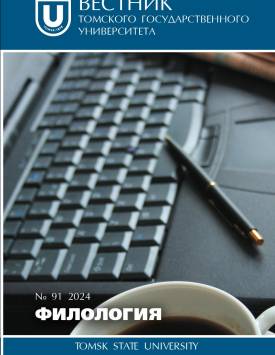Theatrical text and theatrical discourse
The article surveys some examples, in which text theory has been leveraged in the mode appealing both to itself and to discourse theory. This discussion underpins the present research and forms the basis for a distinction between theatrical text and theatrical discourse. The article aims to outline some features of a theatrical discourse, based on a functional analysis of the performance The Seagull as an intersemiotic translation of the eponymous Chekhov’s play. The study was carried out by employing methods such as definitional, descriptive, semiotic, and functional analysis. Since the theatrical text is considered in comparison with the dramatic and the theatrical discourse is compared with the theatrical text, methods of comparative analysis and interpretation were also used. This research focuses on several crucial aspects of text and discourse theories, viewed in pragmatic respect. A theatrical text can be defined as a concrete implementation of the stage language (theatrical discourse). Nevertheless, these concepts cannot be considered completely identical due to some significant differences. One theatrical text can be actualized in several theatrical discourses. Therefore, it is characterized by volatility, mobility, repeatability, renewability, interactivity (explicit or implicit). Theatrical discourse as a communicative practice is not characterized by repeatability, since the configuration of signs will always depend on the situation: time, space, participants, spontaneous words, and other factors. It is proved that the text of the intersemiotic translation into the language of the stage as a blueprint of a perfect performance manifests itself in discourses. Analysis of the theatrical text of a production presented in a certain place at a certain time with certain actors can be referred to as an analysis of theatrical discourse. The authors recreate the original theatrical text in accordance with the situation of the utterance. The functional analysis of the experience of The Seagull play performance, directed by Pavel Kartashev, has led to the inference that the spontaneous intrusion of reality into the polycode text of a stage work being constructed “here” and “now” can trigger the process of desemiotization or a more complex semiotic process of referential interference which means an overlap of one reality (ordinary) and another (mimetic). A dialectical connection is formed between the processes of semiotization and desemiotization, which results in a more intense impact on the cognitive sphere of the recipient and the perception of the image of the performance that drives recipients to draw certain inferences. Thus, a particular discourse is the result of the action (interaction or counteraction) of two forces, two mechanisms of semiosis. The author declares no conflicts of interests.
Keywords
theatrical text, theatrical discourse, semiotization, desemiotization, interpretation, referential interferenceAuthors
| Name | Organization | |
| Chureyeva Olga A. | V.I. Vernadsky Crimean Federal University | au-room-ua@mail.ru |
References

Theatrical text and theatrical discourse | Vestnik Tomskogo gosudarstvennogo universiteta. Filologiya – Tomsk State University Journal of Philology. 2024. № 91. DOI: 10.17223/19986645/91/7
